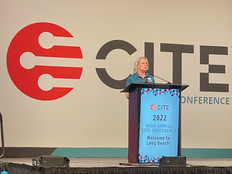Director Of Tech Infrastructure Writes Article On The Public Education System
Related Articles
Necessity is often the mother of invention. At least, that’s what Paul Potter would say. Potter is the director of technological infrastructure at Tomah (Wis.) Area School District, and wrote our cover story “Making an Impression” on Page 30. At Tomah, Potter developed a program for getting teachers immediate feedback on their lessons. Mandates like No Child Left Behind place tremendous emphasis on using data to drive decision making. And nowhere is the data more important and relevant than what comes out of the classroom, particularly when it addresses how well students are learning.
“We felt that the in-classroom assessment was critical. We were spinning our wheels with writing curricula for the classroom,” Potter told EdTech. Like teachers in other school districts, Tomah’s teachers would get the results back from multiple-choice tests, but they still didn’t have a great grasp on what students truly understood about the subject. Armed with necessity, Potter invented a solution to address the gap — an in-house-developed and handheld-based custom testing tool that allows teachers and students to see how they fared on tests and against state curriculum standards in real time. With the new assessment testing program Potter developed, teachers create tests — on the fly — gaining insights about what to focus on in their subsequent lessons.
However, “the really neat thing is the next step — after testing — which is working with the students on skills where they are less proficient,” Potter says. “When people look at technology in education, they often think it’s all about the latest cool software for kids. But there’s a lot that doesn’t have to do with students using software to try to learn. The technology used for the assessment side is an incredibly important part of the puzzle. We have to harness the power of technology on the assessment side, because our teachers are time strapped.”
What happened in Tomah isn’t usual. At school districts across the country, numerous educational technologists and IT practitioners are trying to find a better way to assess what’s right about the way they teach, and what needs tightening up. If necessity is driving you to innovate, consider these insights from Paul Potter’s project:
Integration Is Critical: Potter developed Tomah’s testing software with Visual Studio C# code, which is the same platform that the district’s School Information System runs on. This made tying back to the curriculum plans and state standards much easier.
Pilots Take Time: This project took four years to come to fruition. Tomah is now gradually rolling its testing program out to teachers after a full-year pilot that included 104 elementary, middle and high school teachers. After more than 700 tests have been run off the handhelds, all the kinks are out.
Put Your Teachers in the Driver’s Seat: Potter wrote the code for this application, but the technology wasn’t the driver. Getting a better grasp on assessments consistently came up on teacher’s wish lists. The project grew out of meeting that need. The right form factor — in this case a portable, low-cost PDA — came under consideration after devising the program.
As you assess what to add, and perhaps take off, your project list for the next school year, thumb through the pages of EdTech, and hopefully you’ll find a number of great ideas to consider at your school district.

Editor in Chief, leecop@cdw.com
We’ve Come a Long Way
Commodore Business Machines produced one of the first computers, called the Commodore Personal Electronic Transactor (PET), to receive wide use in schools systems across the country in the late 1970s. Some models were called the “Teacher’s PET.” With an all-metal casing, the Commodore PET could handle demanding school environments, and at about $300 per unit, it fit school district budgets as well. It was the first computer to hit more than a million units sold, and also the first machine that Tomah School District’s Paul Potter programmed back in grade school. The eight-bit computer came fully loaded with eight kilobytes of RAM.







